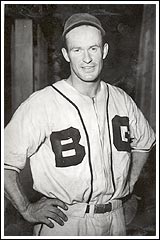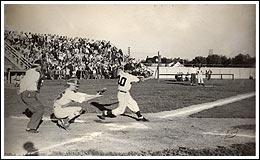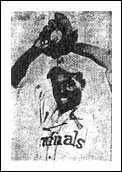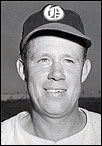How prophetic. Writing in the Brandon Sun, late in the 1948 season, H.L. Crawford noted:
For one thing is certain now, Brandon will be represented in 1949 by a club as strong or stronger than the Greys this year. And brother, that's some team!

On May 21st, 1949 the Brandon Greys opened the season sweeping a twin-bill in Winnipeg.
It was the beginning of one of the most remarkable baseball campaigns on the prairies. 113 days later, the Greys would end a 108-game season with a victory in Minot. It brought their record to 87 wins, 18 losses and 3 ties.
 Along the way, playing-manager Ian Lowe led his charges to success after success - the pennant in the Manitoba Senior League, to a thrilling playoff victory, the title in an exhibition series with Minot, and exhibition wins over traveling clubs such as the Ligon All-Stars, Brooklyn Cuban Giants, Muskogee Cardinals, St. Louis Black Cardinals, and San Francisco Sea Lions.
Along the way, playing-manager Ian Lowe led his charges to success after success - the pennant in the Manitoba Senior League, to a thrilling playoff victory, the title in an exhibition series with Minot, and exhibition wins over traveling clubs such as the Ligon All-Stars, Brooklyn Cuban Giants, Muskogee Cardinals, St. Louis Black Cardinals, and San Francisco Sea Lions.
Greys entered nine tournaments and won top prize money in six and tied for first in another. (Photo of Ian Lowe courtesy of Lil Lowe)
A note in the Brandon Sun:
"Twenty years from now you'll recall your greatest baseball game. And it's a sure thing you'll talk about the night of Sept. 6, 1949, when the Brandon Greys beat Elmwood Giants in a 15-inning thriller."
Canadian right-hander, Manitoba native, Frank Watkins (above right) was both the pitching and hitting star of the championship game.


 An offensive sparkplug for the Greys was Rafe Cabrera (right) who batted .316 and played in all 108 games. Cabrera led the club with 129 runs, 13 homers and 89 runs batted in. Ian Lowe, had the best average, .336.
An offensive sparkplug for the Greys was Rafe Cabrera (right) who batted .316 and played in all 108 games. Cabrera led the club with 129 runs, 13 homers and 89 runs batted in. Ian Lowe, had the best average, .336.
Catcher Ramon Rodriguez (left) led the club (and likely topped all teams in Western Canada) with 54 stolen bases.



The Greys featured outstanding pitching. Walter Dirk "Bubblegum" Gibbons (left), a righthander, won 19 of 24 decisions and led the club with 229 strikeouts. He had a pair of one-hitters and fanned 18 in a single game.

Southpaw Winslow Means (right) finished at 18-4 and fanned 218, including 18 in a single game (a mark later tied by Gibbons). Means had a 7-inning, perfect game at the Indian Head tournament and also had a one-hitter.
 Homebrew Frank Watkins, who won 17 and lost just 3, was the hero of the playoffs as he not only pitched the 15 inning finale but drove in the winning run. Armando Vasquez (right) splitting time between first base and the mound, was a winner in 12 of 13 decisions.
Homebrew Frank Watkins, who won 17 and lost just 3, was the hero of the playoffs as he not only pitched the 15 inning finale but drove in the winning run. Armando Vasquez (right) splitting time between first base and the mound, was a winner in 12 of 13 decisions.
 Left - Action at Brandon's home field -- Kinsmen Memorial Stadium. See the larger versions in the Snapshots section. (Photo courtesy of Lil Lowe)
Left - Action at Brandon's home field -- Kinsmen Memorial Stadium. See the larger versions in the Snapshots section. (Photo courtesy of Lil Lowe)
 Manitoba also had a top notch senior circuit, the Greater Winnipeg Senior League with Selkirk, St. James, St. Boniface, Transcona and CUAC (Canadian Ukranian Athletic Club.
Manitoba also had a top notch senior circuit, the Greater Winnipeg Senior League with Selkirk, St. James, St. Boniface, Transcona and CUAC (Canadian Ukranian Athletic Club.
1949 marked the initial tour by the California Mohawks. The club, mainly California college kids, would return as a barnstorming unit in 1950 before playing as the Medicine Hat Mohawks in the Western Canada League in 1951. At least two of the Mohawks -- infielder Pumpsie Greene and pitcher Curt Barclay -- went on to major league careers.
For the second consecutive season, the powerful Regina Caps captured the Southern League pennant only to be bounced in the playoff finals, this time by the Moose Jaw Purity Canucks. Wilcox Cardinal outfielder Clint Squires captured the 1949 batting crown with a .368 average. Portsider Cliff "Lefty" Harrison of the Caps led all chuckers with a 7 - 1 mark.
 On the tournament trail in Saskatchewan, a pair of tiny communities dominated. If it wasn't Delisle, if was Sceptre taking the top prize.
On the tournament trail in Saskatchewan, a pair of tiny communities dominated. If it wasn't Delisle, if was Sceptre taking the top prize.
Among others, the Bentley's of Delisle copped the rich Lloydminster tourney, the Saskatoon Optimist event (beating Sceptre), Foam Lake (over Sceptre), another Saskatoon tournament and finished second at Moose Jaw.
Sceptre took first money at Nipawin, Saskatoon Exhibition and Rosetown (all over Delisle), Swift Current, Cabri and Watrous.
 It was quite a summer for Wayne "Wimpy" Stephenson who, among other things, was the only non-black to suit up with an American touring team (see the link above to the St. Louis Black Cardinals) :
It was quite a summer for Wayne "Wimpy" Stephenson who, among other things, was the only non-black to suit up with an American touring team (see the link above to the St. Louis Black Cardinals) :
" ... I was playing with the Swift Current Indians at the time (1949). They put a pretty good team in that league with Estevan, Regina, Moose Jaw, all through there. Pretty well the whole team was imported ... and they ran into financial difficulties about the end of June so there was an exhibition game against the St. Louis Black Cardinals ... after the game, I beat them that night, about a 2-1 ball game, I noticed there was only ten guys sitting on the bench so I went over to them and I said gee, I'm out of a job as of tonight. This is the last fund-raiser to help Swift Current pay a few bills and I said, sort of as a joke, do you guys need another chucker for the rest of the summer? The guy said, if you can be ready by eight o'clock tomorrow morning, that's when the bus leaves, be on it and you're part of the team. It just happened that quick you know."" ... Payday was immediately after the game and we split it ten ways. Whatever it was, you got paid every day, no salary or nothing, split the gate ... we came pretty close to winning it in the big ball tournament in Lacombe and that was a little bit bigger pay day but you know your pay in those years would be anywhere from six bucks to fifteen to maybe whatever on any given day. Old man Cobb out of San Antonio he was the manager and owner of the club and he paid the hotel bill and everybody looked after their own meals and every once in awhile you'd stop and get a little dry cleaning done if you had a rainy day or whatever. Most of the time you were in that bloody bus trying to make the next tournament."
The grand adventure ended in late summer at the US border crossing:
" ... At the end of the season, the Cardinals are going to Minot. We went to Estevan and we stopped at Portal, which is the border crossing, and just innocently pulled up to the border because we had plenty of time to get to Minot for the evening contest. This is when the customs guy pulled me aside and said you have no idea what you are about to do heading off to play a cross-country tour with a coloured club and end up, supposedly heading for winter ball in Puerto Rico. He detained me so long, fingerprints and every excuse they could find to try to instill in me that at 19 years of age you'd better not be thinking you're going to survive crossing the states. Somebody will either shoot you or knife you particularly in Florida and the southern states. And, the club couldn't wait because they had to be in Minot to play. So that was the end of it. Off went the gloves, spikes and clothing and I hitch-hiked back to Rosetown in my shirt sleeves."
Stephenson (on the origin of his nickname, taken from a Popeye cartoon character with a passion for hamburgers) :
" ...I think it started in about grade five. Somebody took me to the bigger town and we got introduced to hamburgers for the first time and I had two or three of them and they started to call me Wimpy from that day on. Funny how it sticks with you."
Marvin Ligon, of The Ligon All-Stars (on a 1949 crowd in Regina) :
"I remember one big day in Regina ... we were playing the Capitals and the park was full of fans. I realized later that they were there to see Barbara Ann Scott who had won the gold medal in figure skating in the 1948 Winter Olympics. If that wasn't big enough, she used my glove to go out and throw the first pitch and I didn't even get her autograph."
 Not all of the touring clubs met success.
Not all of the touring clubs met success.
The San Francisco Sea Lions decided to so some exploring on their own. This item, from Regina, was carried in the New York Times:
"Harold Morris, owner of the San Francisco Sea Lions, touring Negro baseball team, was a troubled man when he arrived here today -- minus his ball team.
He said his players jumped the club and signed to play with the Buchanan, Sask., All-Stars for the remainder of the season.
The only "player" Morris has left is Sammy Workman, an armless and legless performer who has been traveling with the team. The Sea Lions have permission from the United States Immigration Department to stay in Canada until the end of August, Morris said. A move, however, now is under way to have the players deported to the United States for jumping their bond, he added." (New York Times, June 30, 1949)

The Muskogee Cardinals were among the barnstorming teams on the prairies in the late 1940s and early 1950s.
The Cardinals claimed to a record of 53-33 on their 1948 Canadian tour.
Right-hander Richard Werthern (right) was to be a mainstay of the 1949 squad. He was reported to have turned down an offer from the Cleveland Buckeyes of the Negro-American League to suit up with the travelling Cardinals. Barnstorming teams, highly popular in Western Canada in the 1930s, began to return after the Second World War as economic prosperity followed followed some dark times for residents of Canada and the United States.
Fore ! Players had to be doubly careful during games in Stavely, Alberta.
" ... Several times during the game, golfers encroached on and interfered with plays in the outfield. In the first of the ninth, one golfer was in the field as far as short and second base, while several were in short center. They interfered and were the cause of two miscues and might have cost Stavely the game. There should be a distinct understanding and adherence to same, between the golfing and baseball managements before someone gets hurt." (The Claresholm Local Press, June 2, 1949)
The Stavely Juniors came from behind with an eagle, make that five runs, in the bottom of the ninth to top Claresholm 16-15 after Claresholm had taken a 15-11 lead with five markers in the top of the ninth.
1949 was the year Canada won the world championship of softball. A Toronto team, Tip Top Tailors, defeated a legendary softball pitcher in the final to take the title.

In 1949, Canadian right-hander Ralph Buxton (born in Rainton, SK, near Regina) was back in the major leaguers with the New York Yankees.
He had made his debut in the majors in 1938 with Philadelphia. In between, he had an outstanding career in the Pacific Coast League with Oakland.
Overall, he pitched in 19 games in MLB, all in relief.
